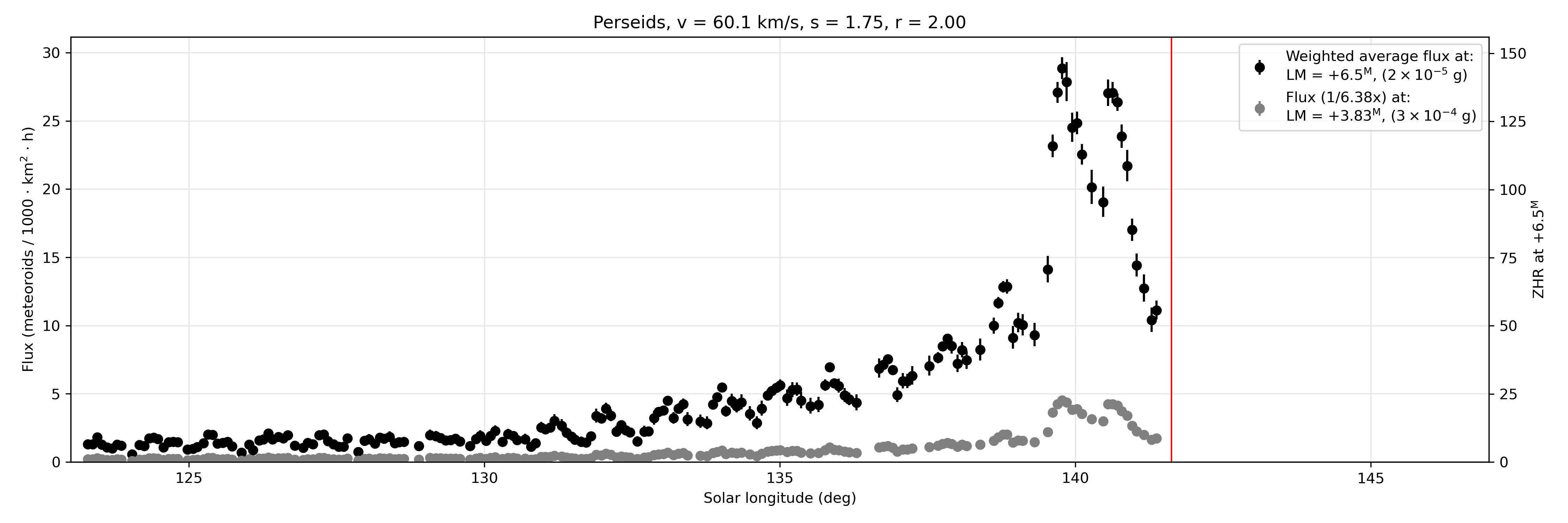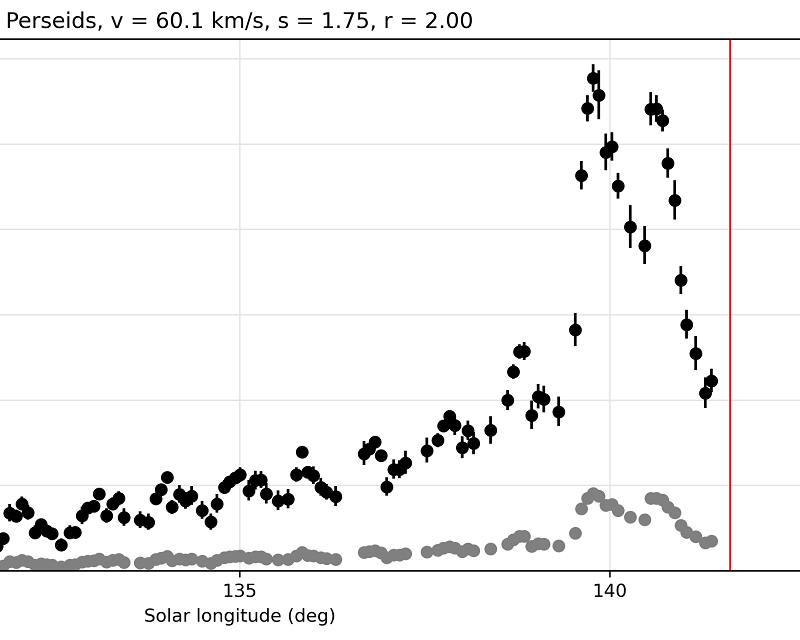Abstract: Two distinct peaks were observed before and after the annual Perseid maximum have been observed by video meteor cameras of the Global Meteor Network, at λʘ = 139.79 ± 0.04° and at λʘ = 140.69 ± 0.04°.
Introduction
In 2022 a paper has been published which describes how to compute meteor shower flux using Global Meteor Network data (Vida et al., 2022). Earlier this month (August 2023) a new tool was made available by Global Meteor Network to compute the real-time activity of meteor showers. Results are released on a new web page on the GMN site. The data shown is produced by combining observations from all cameras that are added to the pipeline, regardless of whether they are paired with another camera or not.
In 2021 the Perseids displayed an unexpected outburst at solar longitude 141.474 ± 0.005° over the North American continent on August 14, 2021 (Jenniskens, 2021; Jenniskens & Miskotte, 2021; Miskotte et al., 2021). Strong Perseid activity had been noticed at this solar longitude by visual observers some years before like in 2018 (Gaarder, 2018; Miskotte, 2019), in 2019 (Vandeputte, 2019; Miskotte & Vandeputte, 2020) and in 2020 (Miskotte, 2020; 2021).
The 2023 Perseid surprise
According to preliminary 2023 data a secondary Perseid peak appeared about one day after the long term Perseid maximum at solar longitude 140° in the meteor shower flux monitoring (Figure 1). Initially it was not clear whether or not this was related to the dust trail that caused the 2021 peak. Radio observations reported online by the International Project for Radio Meteor Observations website clearly show multiple peaks (see Figure 2).

Figure 1 – The Perseids activity according to the meteor shower flux monitoring of the Global Meteor Network.

Figure 2 – Radio meteor activity according to The International Project for Radio Meteor Observations (Hirofumi Sugimoto).
A closer look at the flux profile
Hiroshi Ogawa published a more detailed radio activity profile revealing three maxima (Sugimoto and Ogawa, 2023). Meanwhile all camera data has been uploaded and reduced for the flux profile. The resolution of the video data flux profile is less detailed than that of the radio meteor observations but I could derive the following details from the graph:
- First peak at λʘ= 139.79 ± 0.04°
- Second peak at λʘ= 140.69 ± 0.04°
The theoretical annual Perseid maximum is rather broad and centered at λʘ = 140°, which is halfway at a dip between the above-mentioned peaks and does not emerge distinctly in the flux profile. It looks like Earth crossed additional dust trails before and after the main maximum which added extra activity on the ascending wing and on the descending wing of the broad annual Perseid activity, creating two extra peaks before and after the annual peak.
Peter Jenniskens (2006) predicted the crossing of a filament in 2023, 0.0074 AU from the Earth orbit at λʘ = 139.83 ± 0.2° which could explain the first peak. Jérémie Vaubaillon predicted a possible increased activity on August 14 between 1h and 2h45m UTC (λʘ = 140.74°) when Earth was expected to cross a dust trail released by the parent comet Swift-Tuttle in the year 68 BC. This could explain the second peak. The flux profile shows a shoulder at about λʘ = 141.54° which may be a trace of a concentration that caused the 2021 Perseid outburst at this solar longitude. This shoulder is not confirmed by the radio observations.
Conclusion
The 2023 Perseid activity profile was characterized by multiple peaks probably caused by the transit of a filament at λʘ = 139.83 ± 0.2° as predicted by Jenniskens (2006) and a dust trail at λʘ = 140.74° as predicted by Vaubaillon.
References
Gaarder K. (2018). “2018 Perseid expedition to Crete”. eMetN, 3, 263–266.
Jenniskens P. (2006). Meteor showers and their parent comets. Cambridge.55
Jenniskens P. and Miskotte K. (2021). “Perseid meteor outburst 2021”. eMetN, 6, 460–461.
Jenniskens P. (2021). “Perseid meteor shower outburst 2021”. CBET 5016, 2021 August 14, editor D.W.E. Green.
Miskotte K. (2019). “The Perseids in 2018: Analysis of the visual data”. eMetN, 4, 135–142.
Miskotte K. and Vandeputte M. (2020). “Perseids 2019: another peak in activity around solar longitude 141.0?”. eMetN, 5, 25–29.
Miskotte K. (2020). “Perseids 2020: again, enhanced Perseid activity around solar longitude 141?”. eMetN, 5, 395–397.
Miskotte K. (2021). “Perseids 2020 revisited”. eMetN, 6, 29–30.
Miskotte K., Sugimoto H. and Martin P. (2021). “The big surprise: a late Perseid outburst on August 14, 2021!”. eMetN, 6, 517-525.
Sugimoto H. and Ogawa H. (2023). “Perseids 2023 by worldwide radio meteor observations”. eMetN, 8, this issue.
Vandeputte M. (2019). “Perseid campaign at Aubenas Les Alpes, Haute Provence”. eMetN, 4, 83–88.
Vida D., Blaauw Erskine R.C., Brown P.G., Kambulow J., Campbell-Brown M., Mazur M.J. (2022). “Computing optical meteor flux using Global Meteor Network data”. Monthly Notices of the Royal Astronomical Society, 515, 2322–2339.


